TV spokesperson scandals can harm a brand’s good name. Companies often rush to fix things afterward. We will look at how brands can bounce back from these scandals.
We will dig into strategies for fixing a brand’s image. This includes managing crises and protecting reputation. We’ll explore how brands can survive tough times, from bad celebrity endorsements to strong public relations.
Discover how famous brands came back from crises. We’ll look at real examples and share tips on handling a crisis. Is your brand ready to overcome a TV spokesperson scandal?
Understanding PR Crises and Their Impact on Brands
In our digital age, a PR crisis can deeply affect a brand’s image and success. It’s about anything bad that harms a brand’s good name. This includes customer complaints, social media issues, faulty products, legal issues, or scandals.
Brands need to constantly check online what people say and think about them. This involves looking at social media, news, and reviews. It helps brands know the public’s opinions.
“Reputation management is not about making problems disappear, but about responding effectively to regain trust and rebuild the brand image.”
Knowing the mood of online talks is key. It helps decide how to react properly. By understanding people’s feelings, brands can see how serious a crisis is. Then, they can act right to fix it.
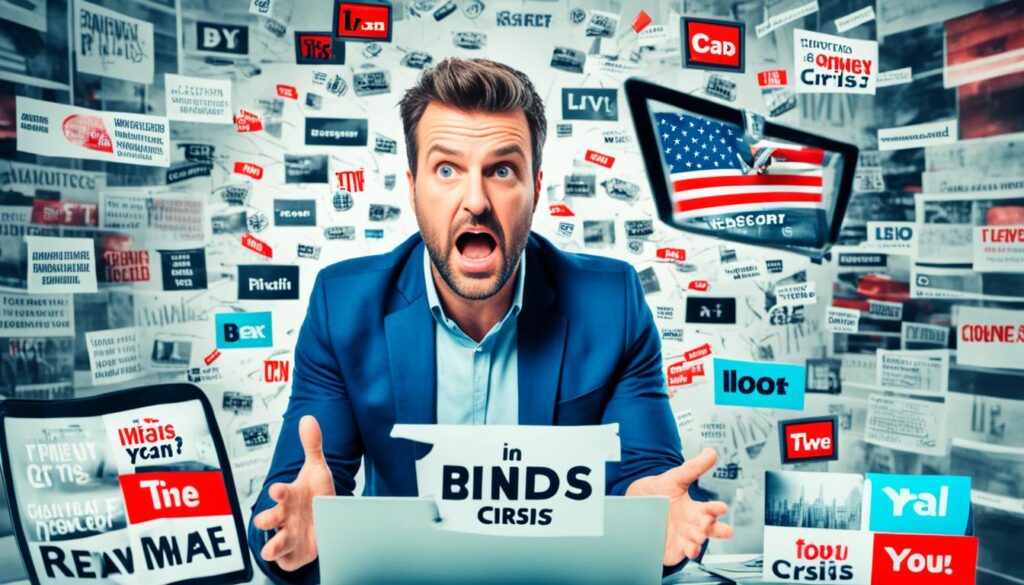
| Impact of PR Crises on Brands |
|---|
| Damage to brand reputation and trust |
| Loss of customer loyalty and trust |
| Decline in sales and revenue |
| Negative media coverage and public perception |
| Legal and regulatory consequences |
| Adverse impact on business partnerships and investor confidence |
PR crises can hurt a brand’s name, customer faith, and finances a lot. So, having a plan ready to manage crises is key for brands.
Key Takeaways
- A PR crisis refers to a detrimental event that poses a threat to a brand’s reputation.
- PR crises can arise from various sources, such as customer complaints, social media backlash, product defects, legal matters, or media scandals.
- Brand mentions and sentiment analysis play a crucial role in understanding and managing PR crises effectively.
- Brands should monitor their brand mentions and sentiment analysis to assess the level of crisis and determine the appropriate response.
- PR crises can have a significant impact on brand reputation, customer loyalty, sales, and overall business success.
Identifying Different Levels of PR Crises
Understanding the different levels of PR crises is crucial. Each level needs a specific approach for management and response. Let’s dive into these levels and what makes them unique:
Level 1 PR Crises
Level 1 crises are urgent. They require immediate action and a strong plan. Situations like product recalls or workplace harassment need quick, thoughtful responses to reduce damage and regain trust.
Level 2 PR Crises
Customer complaints and negative feedback define Level 2 PR crises. Without quick action, these issues could severely harm a brand’s image. Prompt and effective solutions are key to managing these situations and avoiding bigger problems.
Level 3 PR Crises
Sometimes, a crisis in a related industry can indirectly impact your brand. This is called a level 3 PR crisis. Even if it’s not directly your crisis, the association can hurt your reputation. Watching competitors and reacting fast is vital to handle these risks successfully.
Knowing the different PR crisis levels helps brands prepare and respond well. Recognizing their unique features allows for better protection of a brand’s image and keeping stakeholder trust strong.
Strategies for Managing Level 1 PR Crises
Level 1 PR crises can hurt a brand’s image. A detailed response plan is needed. Brands must quickly deal with negative comments on social media, news sites, and blogs.
They should keep an eye on the talk about the crisis. It’s important to answer any questions the public might have without delay.
A key part of a good response is saying sorry the right way. This apology needs to be seen easily on the brand’s site. It also should be shared on all important social media channels.
The apology must show true regret and take blame for any hurt caused. It should talk about how the brand will fix the issue and stop it from happening again.
Having many ways to talk to people is crucial for handling Level 1 PR crises. Brands need to work with the news media to share their side of the story correctly. They should send out news releases, hold news conferences, and give interviews to clear up any media questions or worries.
“Transparency in communication is key during a PR crisis. By addressing the negative mentions head-on and sharing a well-crafted apology, brands can demonstrate their commitment to resolving the issue and rebuilding trust with their audience.”
Talking openly inside the company is also very important during Level 1 PR crises. Workers need to know what’s happening. They should get key points to discuss and be urged to share correct info with others. This helps keep the message consistent and stops false stories from spreading.
It is vital for brands to use various ways to talk to their audience. This means using social media, email newsletters, and blogs to share info and updates. By using many communication methods, brands can reach more people and show they are open.
Dealing with Level 1 PR crises requires acting quickly and having a good plan for responding. By quickly tackling negative comments, saying sorry the right way, working with the media, and using many communication ways, brands can handle these crises well. This helps limit damage to their reputation.
Strategies for Managing Level 2 PR Crises
To handle Level 2 PR crises well, brands need a proactive and quick approach. They should listen carefully on social media to catch problems early and respond to complaints fast. This helps stop small issues from becoming big problems and keeps their reputation strong.
Employing Effective Social Listening
Listening well on social media is key to managing PR crises. By keeping an eye on brand mentions and conversations online, companies can understand what customers think. They can quickly spot and fix emerging issues. Social listening tools help track important keywords, catching problems early.
“Effective social listening is like having your ear to the ground, enabling you to anticipate issues before they escalate.”
Proactive Identification of Crisis Indicators
Finding crisis signs early is crucial for handling them well. Brands need systems to watch feedback and mentions across platforms. This lets them see trends that could lead to trouble. Acting before issues grow ensures they can keep small problems from getting worse.
Swift and Confident Action
Acting quickly is vital in Level 2 PR crises. When a problem pops up, brands should roll out their response plan fast. This includes using crisis management teams and talking to customers right away. Being decisive shows the brand cares about fixing the issue. It helps protect their image.
By listening, identifying issues early, and acting decisively, brands can handle PR crises well. This approach limits damage and keeps their image positive.
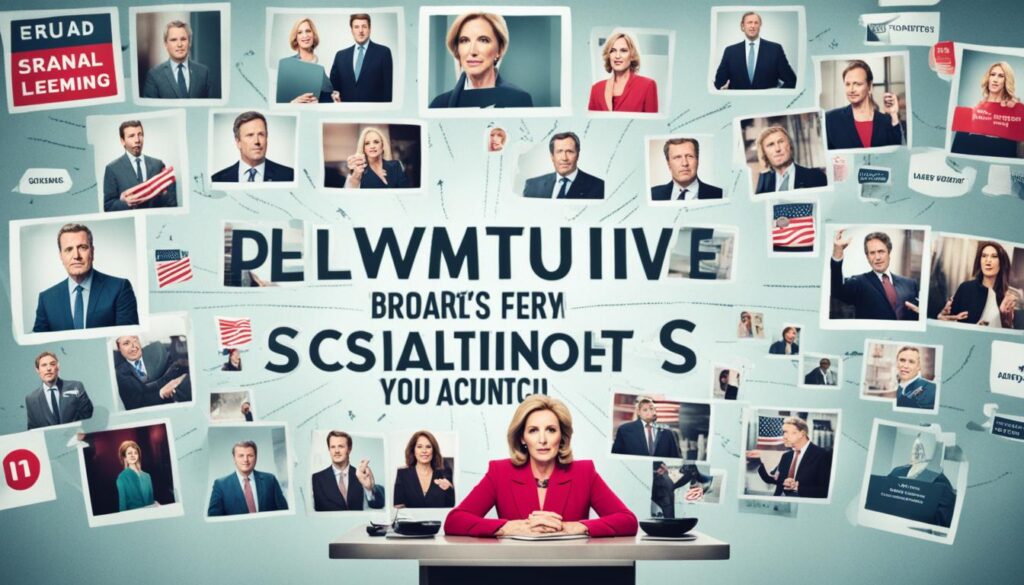
Strategies for Managing Level 3 PR Crises
Level 3 PR crises involve challenges from competitors or related industries. To protect your brand, use strategies like competitive intelligence, competitor monitoring, and fast responses.
Competitive Intelligence:
Knowing your competitors’ actions helps in managing level 3 PR crises. Learn about their audience, marketing, and campaigns. This helps you find weak spots and stay ready.
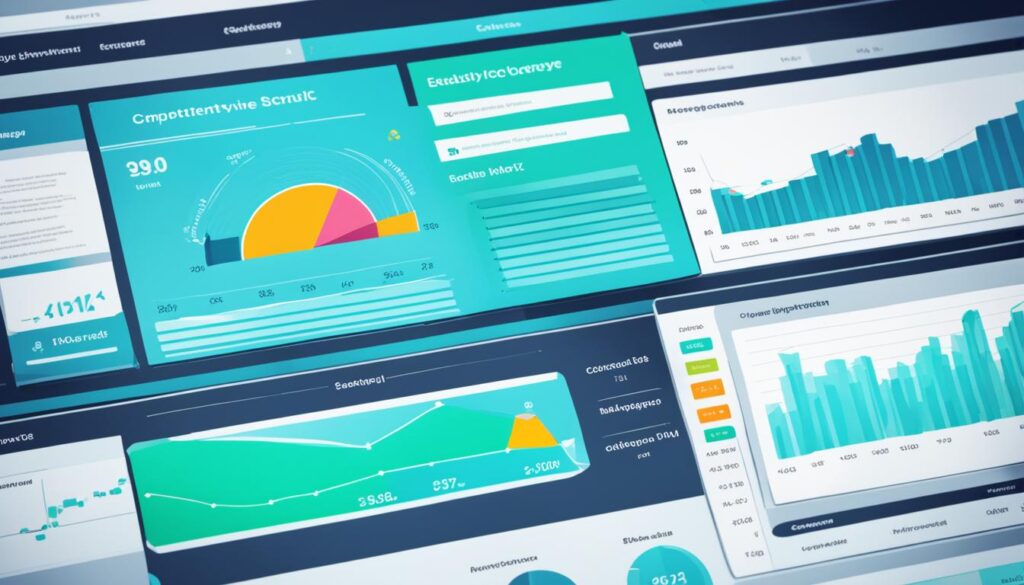
Monitoring Competitors:
Keep an eye on your competitors’ online activities and news. This lets you spot problems early. It helps you steer your brand away from these crises.
Swift Response:
Fast action is key in level 3 PR crises. Use your insights to tackle issues early. Acknowledge problems and communicate clearly to keep your brand’s integrity.
“Swift responses based on competitive intelligence and monitoring can help your brand establish a clear distance from potential crises while maintaining a strong reputation.”
Use these strategies to handle level 3 PR crises and protect your reputation. Stay ahead with competitive intelligence, watchful monitoring, and quick actions. This helps your brand stay positive.
Preventing PR Crises: Implementing Effective Guidelines and Policies
Stopping PR crises before they start is key. Companies can do this by setting up strong rules for how they talk and what they share. Following these rules helps lower the chance of damage to their reputation. It also makes them quicker to handle any issues that might come up.
Content Guidelines
Content rules help make sure all messages are consistent and fit the brand. They define the right tone, style, and words to express the brand’s values. This way, businesses can keep a solid and unified image. They also avoid misunderstandings or wrong representations.
These rules should cover everything from social media posts to blog articles. They need to stress being accurate, professional, and following legal and ethical standards.
Social Media Policy
With the digital world we live in, a strong social media policy is a must. It tells employees how to handle the brand’s accounts correctly. A good policy includes guidance on what to post, how to interact with followers, and what to do in a crisis.
Having clear rules for social media helps avoid mistakes. The policy should give direction on dealing with negative feedback, customer complaints, and delicate topics. With regular training and monitoring, brands can stick to these guidelines and lower any risks.
Proofreading and Approval Process
Checking content carefully before it goes live is crucial for avoiding crises. This means reviewing everything from tweets to interview answers. Having a detailed process for approving content ensures it’s correct, lawful, and matches the brand. This step involves team members from legal, marketing, and PR to look out for any issues.
By setting up a good approval process, companies make sure their content reflects their brand well. This process helps spot potential problems early on.
Setting up strong guidelines and policies is the foundation for preventing crises. By making rules for content, social media, and review processes, companies can keep their reputation safe.

| Effective Guidelines and Policies | Benefits |
|---|---|
| Content Guidelines | Ensures consistent messaging Strengthens brand image Reduces miscommunication or misrepresentation |
| Social Media Policy | Sets expectations for behavior Guides content creation and crisis response Minimizes social media blunders |
| Proofreading and Approval Process | Ensures accuracy and compliance Aligns with brand values and guidelines Identifies potential issues or concerns |
Best Practices for Effective Crisis Management
Having a solid crisis management plan is key. It acts as a guide for handling possible crises. It details actions to limit damage and safeguard the brand’s name.
Yet, just having a plan isn’t enough. A committed crisis response team is needed to bring it to life. This team should be varied, bringing together people with unique insights and skills. Different viewpoints help in assessing the situation, thinking up solutions, and making smart choices.
Table:
| Components of an Effective Crisis Management Plan | Roles and Responsibilities of the Crisis Response Team |
|---|---|
| – Identification of potential crises | – Team leader to coordinate actions |
| – Risk assessment and prioritization | – Spokesperson for media communication |
| – Clear communication protocols | – Researcher to gather relevant information |
| – Stakeholder engagement strategies | – Legal representative for guidance |
Having a well-chosen media spokesperson is vital. They represent the brand during a crisis. They must be skilled, informed, and calm, especially when faced with tough questions.
By valuing diversity and a team approach, brands can better manage crises. Using different perspectives and knowledge, the team can create detailed, strategic plans. These plans take into account the needs of various stakeholders.
Managing crises effectively means being prepared before they occur. With a robust crisis management plan, a diverse team, and the right spokesperson, brands can withstand crises. They can protect their reputation and come out stronger.
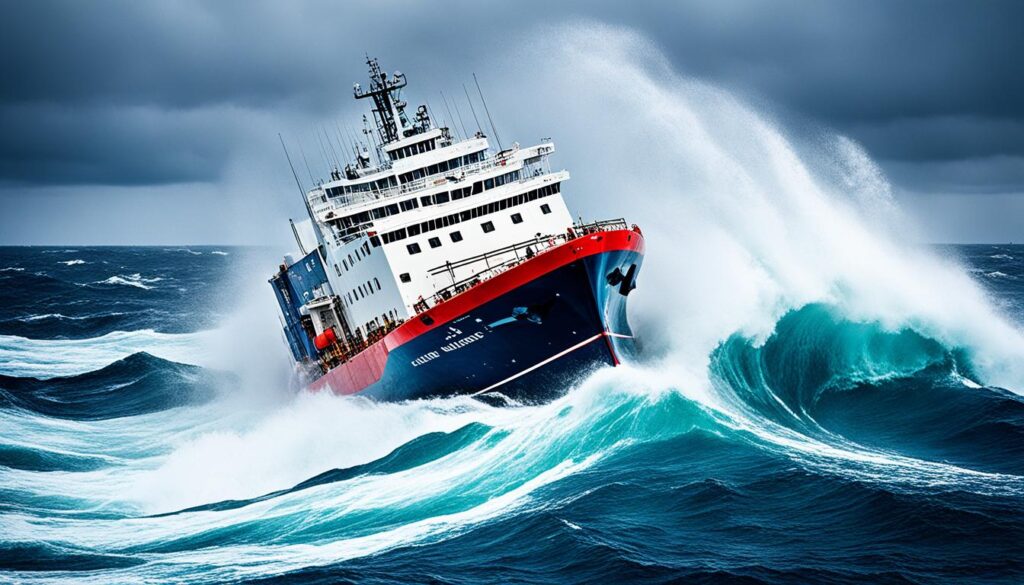
Learning from Crisis Management Examples: Success Stories
Looking at successful crisis management shows us smart ways to handle tough situations. We will look at success stories from Cracker Barrel, Pepsi, and Johnson & Johnson.
Cracker Barrel Crisis Management
Cracker Barrel faced a crisis quietly. They chose silence over speaking out, which helped calm things down. This silence stopped things from getting worse. With time, they managed to rebuild their good name.
Pepsi Crisis Management
Pepsi had issues with a Kendall Jenner ad that upset people. They quickly said sorry and took steps to fix it. They showed they cared and worked fast to make things right. This approach helped save their image.
Johnson & Johnson Crisis Management
Johnson & Johnson had to deal with poisoned Tylenol pills in the 1980s. They quickly pulled their products and worked with the police. They also made their products safer. Their fast and open response helped protect their customers and built more trust in their brand.
These stories teach us that each brand needs its own way of dealing with crises. Cracker Barrel, Pepsi, and Johnson & Johnson used different methods that worked for them. This helped them stay strong through tough times. We can learn a lot from how they handled their situations.

| Brand | Key Successes |
|---|---|
| Cracker Barrel | – Opted for a strategic silence approach – Prevention of further escalation – Reputation recovery |
| Pepsi | – Acknowledged concerns promptly – Demonstrated empathy and willingness to rectify – Efficient crisis resolution |
| Johnson & Johnson | – Swift and transparent response – Product recall and enhanced safety measures – Strengthened trust and reputation protection |
Learning from Crisis Management Examples: Failures and Lessons
Failure in crisis management teaches valuable lessons. Brands learn from past mistakes. This way, they develop strategies for future prevention.
Uber Crisis Management
Uber’s story is one of crisis mismanagement. They dealt with workplace scandals. Their slow response led to major public backlash and loss of trust. This showed how important it is to act quickly, with transparency, and address issues to shield your reputation.
Hurricane Katrina Crisis Management
Hurricane Katrina’s response was poorly managed. The slow government action worsened the hurricane’s effects. It underlined the need for ready plans, effective communication, and quick actions to lessen crises impacts and safeguard affected people.
Bhopal Disaster Crisis Management
The Bhopal disaster in 1984 was a tragic industrial incident. A gas leak caused massive casualties and long-term health problems. It stressed the necessity for strict safety measures, clear communication, and responsibility in hazardous industries. Learning from such events is crucial to avoid repeating history.
“Failure is not the end; it is an opportunity to learn and improve. By studying crisis management failures, organizations can develop strategies to protect their reputation and respond effectively to future challenges.”
| Failure Example | Lessons Learned |
|---|---|
| Uber Crisis Management | Transparency, swift action, commitment to addressing issues |
| Hurricane Katrina Crisis Management | Preparation, coordination, efficient communication |
| Bhopal Disaster Crisis Management | Safety protocols, transparent communication, accountability |
Failure is a chance to learn and get better. By looking into past crisis management mistakes, companies can create plans. These plans help safeguard their reputation and tackle future issues effectively.
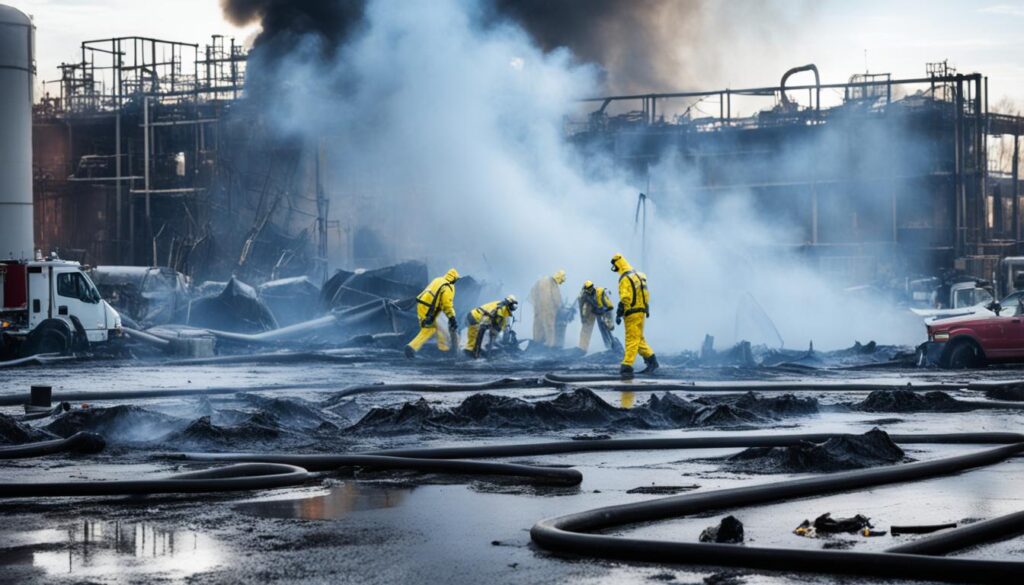
Crisis Management in the Face of the COVID-19 Pandemic
The COVID-19 pandemic has posed huge challenges globally. Managing the crisis effectively is key to keep a business’s reputation and operations safe. A great example of this is Cleveland Clinic Abu Dhabi.
Cleveland Clinic Abu Dhabi focused on being prepared, working together, and caring for their employees and stakeholders. They used specific crisis management strategies for the pandemic. This helped them to face the crisis well.
They made quick, informed decisions by staying up-to-date with pandemic information. This protected their staff and patients. It showed the importance of quick and smart decision-making during a crisis.
They worked closely with everyone involved. This included their employees, patients, and partners. By involving everyone in decisions, they built trust and adapted to new challenges quickly. It proves working together can make a big difference.

Switching to remote work was key. Cleveland Clinic Abu Dhabi quickly made it possible for their staff to work from home. This kept their operations running smoothly without lowering patient care quality. It shows their dedication to their employees’ well-being and their work efficiency.
The story of Cleveland Clinic Abu Dhabi highlights how preparedness, teamwork, and the ability to adapt are vital. These qualities help organizations overcome the difficult times brought by COVID-19. By using smart crisis management strategies, companies can get through tough situations and come out stronger.
Conclusion: The Importance of Effective Crisis Management
In today’s world, managing crises well is key for a brand’s image and toughness. It’s important to have a ready plan and people who know how to speak during a crisis. Addressing problems quickly and clearly helps keep trust with your audience.
Studying successes and failures in crisis management is beneficial. Looking at how Cracker Barrel stayed quiet and how Johnson & Johnson was open during the Tylenol issue teaches valuable lessons. On the other hand, Uber’s failures are lessons on what not to do.
To keep a good reputation, companies must focus on handling crises well. By using sound strategies and being ready, brands can grow stronger. Crisis management isn’t just about fixing things; it’s about protecting your brand’s image for the future.